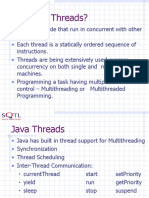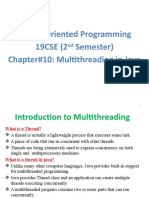0% found this document useful (0 votes)
4 views6 pages(6 Pages) Multi Threading
The document provides an overview of multithreading, defining it as the capability of a CPU to execute multiple threads concurrently, and outlines its benefits such as improved CPU utilization and enhanced performance. It details how Java supports multithreading through classes and interfaces, methods for creating threads, and the lifecycle of threads. Additionally, it covers thread priorities and daemon threads, explaining their significance and usage in Java applications.
Uploaded by
Mca MglCopyright
© © All Rights Reserved
We take content rights seriously. If you suspect this is your content, claim it here.
Available Formats
Download as PDF, TXT or read online on Scribd
0% found this document useful (0 votes)
4 views6 pages(6 Pages) Multi Threading
The document provides an overview of multithreading, defining it as the capability of a CPU to execute multiple threads concurrently, and outlines its benefits such as improved CPU utilization and enhanced performance. It details how Java supports multithreading through classes and interfaces, methods for creating threads, and the lifecycle of threads. Additionally, it covers thread priorities and daemon threads, explaining their significance and usage in Java applications.
Uploaded by
Mca MglCopyright
© © All Rights Reserved
We take content rights seriously. If you suspect this is your content, claim it here.
Available Formats
Download as PDF, TXT or read online on Scribd
/ 6




















































































